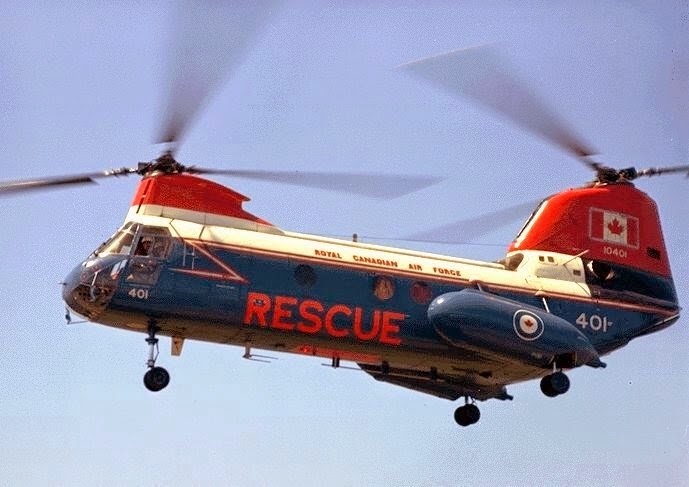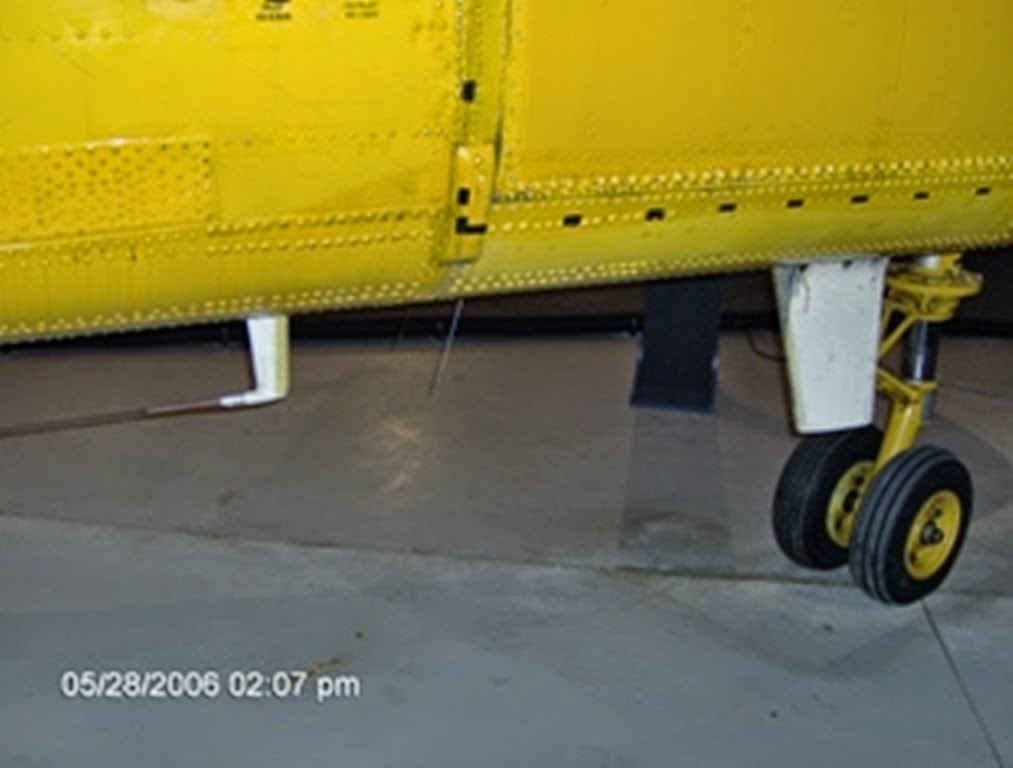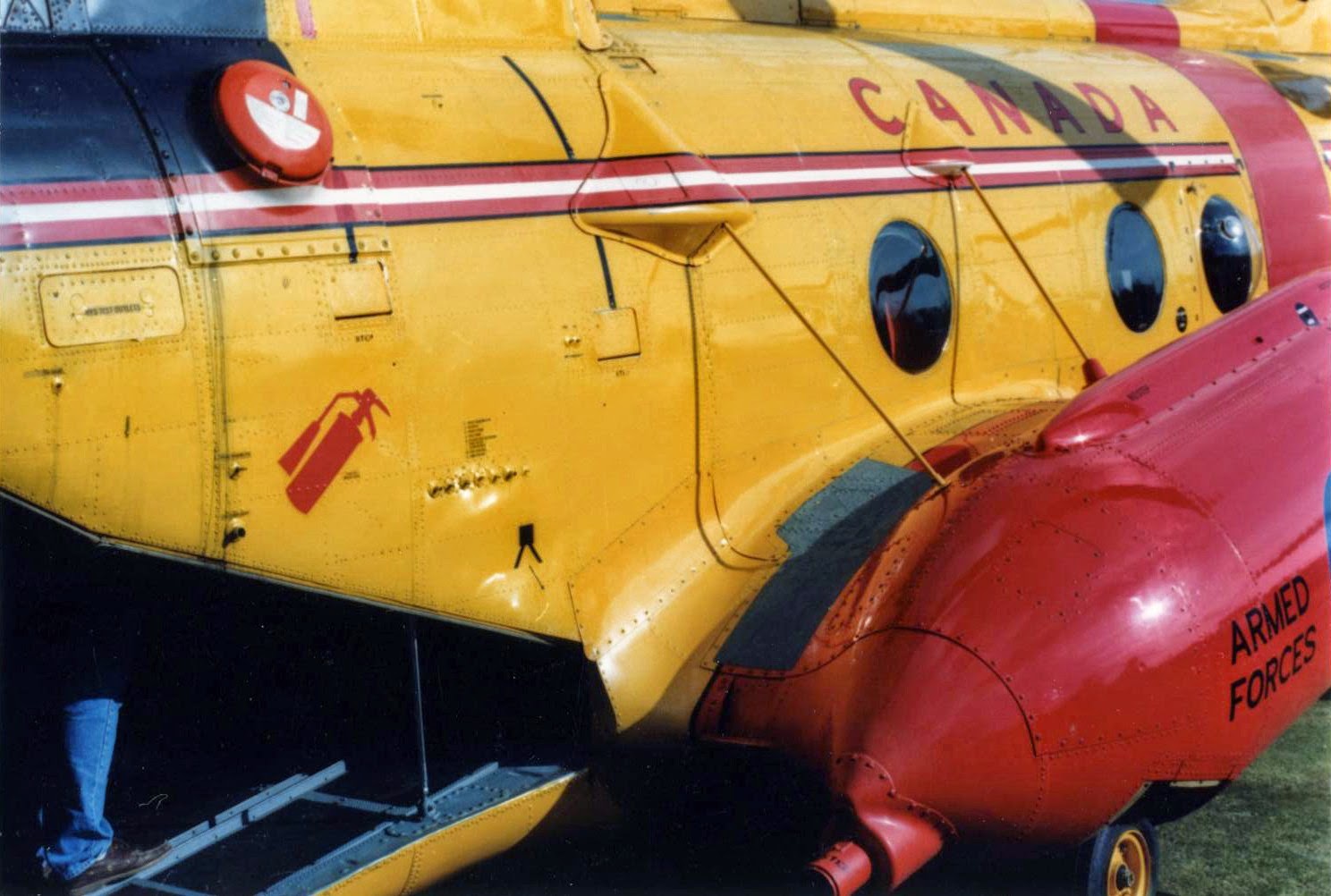Labrador 401 in Red White and Blue Colours
CH-113 Labrador - Canadian H-46s for the Modeler
– The Next Phase
And so begins the next phase of my blog, which as an avid
modeler recently told me, while a very narrow focus the subject is
none-the-less interesting. His observations and comments are in fact the
reality for H-46, and variants aficionados and it just occurred to me that the
focus might in some ways be getting even narrower while hopefully still having
appeal to the less ardent H-46, KV-107 or Labrador/Voyageur fan.
The focus and intent of this phase of the blog will be to
deal with individual airframes as they evolved from time of purchase to
retirement. Essentially Labradors will be looked at individually while in red,
white and blue livery wearing 400 series numbers. The second chapter will
discuss Labradors still in red, white and blue, but renumbered with 300 series
numbers. The third chapter will move into the era of yellow pre-SARCUP
helicopters before finally moving on to the yellow SARCUP era.
Once discussions on Labradors are finished focus will shift
to green “ARMY” Voyageurs wearing 400 series numbers, following which there
will be some discussion of green Voyageurs with 300 series numbers. As
Voyageurs were transferred to Air Force inventory to take up search and rescue
duties, still wearing army green albeit with temporary SAR markings so too will
the focus of the blog shift somewhat. As with the Labrador chapters, following
transition from early liveries and numbering the blog topics will shift to
pre-SARCUP yellow aircraft and finally the last chapter in this next phase will
deal with SARCUP Voyageurs. That done, the blog will venture into the area of
kits.
I must confess that I have used the words “discuss,
discussed and discussion” somewhat gratuitously because in fact discussion will
simply be statements on my observations of the above subjects based almost
entirely on available pictures with a smattering of information about each
airframe found on the Internet and in Patrick Martin’s books mixed in with my
own personal recollections.
Like all CH-113 Labrador variants, 401 was a model
107-II-9 numbered 9301 at the time of construction. 401 Was TOS (taken on
strength) by the Royal Canadian Air Force on September 24, 1963 as 10401 which
was ferried to Canada as N6680D were it was received on 11 October 1963 at RCAF
Station Trenton, Ontario, home to 102 (KU) Composite Unit.
.jpg)
In their book “Royal Canadian Air Force – Aircraft and
Finish and Markings – 1947 to 1968”, Patrick Martin and John Griffin point out
that 10401 is the only aircraft to be delivered with no white in the fuselage
lighting stripe and as is obvious in the above photograph, fluorescent orange
rotor pylons. Fluorescent orange markings were intended as an anti-collision
measure. One of the interesting but obscure points Martin and Griffin make that
most modelers may miss is that until May 22, 1964 all six rotor tips were
yellow. After that date, the three aft rotor tips were painted red. In the
photo above the roundels are co-located on the aft fuselage next to the last
three serial numbers, which are clearly white in colour. On November 17, 1963,
the roundels were relocated to the tanks. It was not until February 26, 1965
that the fluorescent orange was changed to red.
My observations include, over and above antennae located on
the nose, underbelly and on the sync shaft tunnel are that there is a fuel dump
tube located on the outside and back end of the tanks, something that when this
blog was started I was unsure about. The aircraft above also has grey seals around
the starboard emergency exit windows and therefore in all probability grey
seals around the left side emergency exit and door. Most notable, however is the lack of engine inlet screens. Even
subtler than the foregoing observations is the demarcation of the fluorescent
orange and white paint on the very front of the aft rotor pylon. It is
difficult to say with any certainty whether or not the picture below is
equipped with SARAH aft of the cockpit… if it does not have SARAH the picture
would likely have been taken earlier than the picture above. Finally yet
significantly is the lack of any fuel tank/sponson braces on the 401 in either
the picture above or below.
.jpg)
While it may be hard to say which picture was taken first,
it is my assertion that the above photo was taken earlier than the first, based
only on the strength of it not having a SARAH antenna and that it lacks a Red
Ensign on the aft pylon even though the second picture shows 401 with a better
(read newer) paint job. Either way, note the crispness of the Royal Canadian
Air Force titles compared with the picture preceding it, the location of the
roundel and numbers in three locations (pylon, fuselage and nose). As for
subtle points, note the narrow black exhaust strip and the nearness of the front
edge of the black strip to the front of the exhaust and of course the even or
consistent shape of the leading edge of the black exhaust strip. Again we can
see that there are still no tank/sponson braces. In the above photo we can also
see that the last three serials have been placed just below the pilot’s cockpit
glass door.

The first thing one sees when looking at the above photo of
401 is the inclusion of the Central Experimentation and Proving Establishment
(CEPE) crest on the tank. The CEPE bear crest is on both tanks. The side
profile gives the modeler a decent look at the antenna placement as the
aircraft enters RCAF service. You can also see the placement of the HF antenna
starting just above the forward part of the lightning stripe and ending
slightly higher up the side of the fuselage and a few inches aft of the engine
inlet, which now have FOD (foreign object damage) screens installed to protect
the engines from ice and ground debris when landing away from unprepared
landing zones, common to the SAR role. Still looking at the rear of the
aircraft, note that the opening in the aft pylon is trimmed in silver. The
above picture gives a good view of the landing gear, which shows the nose gear
wheel to be white or aluminium even though it was not until March 10, 1970 that
official drawings were amended to include aluminium wheels and blue struts. The
last few observations are that 401 has a SARAH antennae fitted aft of the
cockpit greenhouse, the left side fuel dump is clearly visible on the fuel
tank/sponson and finally as suggested above, the left side emergency window
exit does indeed have a grey seal… however the emergency door exit does not.
Different from the previous pictures is the addition of a single tank/sponson
brace. The brace does not appear to have a fairing. While the second photo
shows the last three serials on the nose, a chronologically accurate photo (the
third in this series) shows the numbers off again.

No new info in the above picture, but a
reaffirmation of some of earlier comments. The picture gives us a bit of a look
at the left side pitot tube located just above and behind the pilot’s glass
emergency door. Like the previous picture we can clearly see the three left
side static discharge ports. In the previous picture we get a better indication
of where the static discharge ports are in relation to the fluorescent orange
“R” in RESCUE. Other than the location of the various antennae including SARAH,
note the pattern of black exhaust on aft fuselage and for this particular
aircraft the peeled paint in and around the forward rotor pylon. Again note the
demarcation between the white area around the engine inlets and the fluorescent
red paint on the aft rotor pylon. The still single tank brace does still not
have a fairing and is barely discernible over the roundel even when the picture
is enlarged. Once again, the last three serials are not in place on the nose
and the aircraft has to this point retained the fuel dump tubes as installed by
Boeing Vertol.

The cover picture for the January/February 1964 edition of
Roundel magazine (the Royal Canadian Air Force magazine of the day) offers next
to nothing new other than the CEPE official crest aft of the front Dutch door
and ahead of the first cabin window. One other thing to note is that the front
nose wheel appears to be blue, or at least it is not white or aluminium. It is
possible that the left wheel has an aluminium rim whereas the right side wheel
has a blue rim? There also appears to be no mirrors at this point.

A few things to note in the picture above, including the
change from the Red Ensign to the Canadian flag…the Red Ensign is thought to
have remained on some aircraft until 1965. Moving down from the flag we can see
that the black exhaust strip covers a larger area, as the white area below the
original exhaust strip is now also black. The engine inlet area is black, but I
am confident this is a temporary maintenance related state. While the last
three white serials remain on the aft fuselage. The roundel, which in this
picture has a small maple leaf, is now located on the tank. As previously
noted, the roundel was officially moved to the tanks 17 November 1963. It is
clear now that the tanks have two sponson braces with fairings. The emergency
door seals are blue and finally the door handles on the Dutch door and cockpit
glass doors are red with a silver lock. It is difficult to say, but it appears,
if you know where to look and at what to look at, the aircraft now has mirrors
and that the mirrors are blue. The last three serials are once again on the
forward portion of the fuselage.

Still wearing Royal Canadian Air Force titles,
401 has the small leaf on the tank mounted roundel… the last three white
serials are on the aft fuselage just above one of the drain vent covers, which
we have not previously in any of the presented pictures. The black exhaust area
leading edge is straight and goes the full width from the bottom of the red aft
rotor pylon to the lightning stripe and we can clearly see the two tank braces
with fairings. We can also see in this photo that 401 has the new style dump
tubes at the extreme aft end of the tanks/sponsons and that the helo has
mirrors on the nose so the pilots can view them through the chin blisters. With
the Dutch door open we get a peek into the cabin area at the black and yellow
barber poled Swedish boom. Slightly ahead of the Dutch door is the SARAH
antenna. Looking at the aft end of the airframe, we can see that 401 has the
original tail without the APU. This the first photo that shows the white
portion of the aft rotor pylon as being red instead of having the white at the
front end.

Like the picture before it, the above photo has
401 still displaying Royal Canadian Air Force titles and the small maple leaf
in the tank-mounted roundel. Unlike any of the previous photos, particularly
the coloured ones red circles are clearly noticeable around the filler cap on
the tanks and around the SAS static discharge ports on the nose. The nose
mounted antennal can be seen as can the side mounted HF antenna above the
lightning stripe and the SARAH antenna. You should also be able to see the
third pitot tube mounted, in the white, above and slightly aft of the pilot’s
cockpit glass. Blue mirrors and the two tank braces are also visible in the
above picture. New is the black area at the front of the aft rotor pylon
clamshell doors. The black exhaust area still has a straight leading edge. As
we have come to expect at this stage of its brief service life, 401 has white
last three serials on both the aft fuselage and the nose. Also noticeable is that 401 still has the
original Lab tail, engine inlet screens and new style dump tubes. The opening
on the aft pylon behind the Canada flag does not have the silver edge and
finally the emergency exit seals and wheels like the mirrors are all blue.
.jpg)
While a nice picture, I can see nothing new in
the above picture.
The picture below is taken at Arnprior, Ontario,
Boeing Vertol’s Canadian overhaul and repair facility. It is difficult to say
when the picture was taken as the aircraft is still wearing Royal Canadian Air
Force titles, which remained until approximately April 4, 1968. The picture
also gives one a reasonable look at the nose-mounted antennae. Given all of the
indicators it is likely 401 is at Arnprior for a scheduled overhaul and not for
repairs because of damage. We do know that 401 incurred fire damage on 22nd
of July 1969 and that it was likely repaired at Arnprior before being returned
to service. It is almost a certainty the fire occurred after the picture below
was taken as we have already indicated 401 is still wearing Royal Canadian Air
Force titles when we know that titles changed to the Canadian Armed Forces
asymmetrical titles in April of 1968, a year and a bit before the fire.
On April 4th of the 1968, the Royal Canadian Air
Force titles were removed and replaced with Canadian Armed Forces titles. The
asymmetrical titles had Canadian Armed Forces on the port side and the French
version “Forces Armee Canadienne” on the starboard side. Later in 1968 a
squadron crest was added to the left side of the fuselage, which will help us
approximate the date of some photos.
- March
10, 1970 Fluorescent
RESCUE/SAUVETAGE titles
- May
5, 1970 Fluorescent RESCUE/RESCUE titles
- August
4, 1971 last three serials changed back to white from black
On 22 July 1969 401 suffered a major fire. The
aircraft was sent to Arnprior, repaired and eventually returned to service.
Close attention to pictures taken after the above photo of repairs being made
at Arnprior should show 401 with a APUless Voyageur tail or more accurately a
former USMC tail. The Marine Corps removed tails from their early model H-46s
as they were separating on hard landings during combat action in the Vietnam
War. Their machines returned to service with beefed up tails while some of the
discarded tails were used for repairs of damaged aircraft from at least Canada,
but presumably for other countries as well.
For a few months in 1970 (May to November) the fluorescent
RESCUE on the starboard side was replaced with SAUVETAGE before reverting to
RESCUE. In August of 1971, and again, for a short time the last three serials
were changed from white to black and then back to white. The photo of 401 shows
the last three serials as black suggesting the photo was taken in mid to late
1971.
Other than the change to asymmetrical titles and black
serials, the most notable thing to me is the inclusion of white “hash marks”
around the emergency exits.
19 November 1971 (Have also seen this date as 1 Dec 71) CAF
Renumbered to 11301.

.jpg)



.JPG)


.JPG)


.jpg)
.jpg)






.jpg)
.jpg)
.jpg)


.JPG)








BQ51Qet32Q~~60_12.jpg)






.jpg)



+-+Jeff+W+-+Approved.jpg)





.jpg)

















.jpg)
BQ51Qet32Q~~60_12.jpg)

+1974-Namao-450+West.jpg)

.jpg)

.jpg)